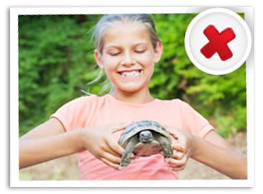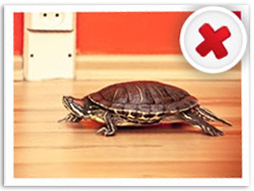Turtles (Reeve’s Turtles)
Turtles (Reeve’s Turtles)
Needs
Here’s a simple checklist to assist you in taking proper care of your turtle. It is not easy to take care of water turtle so updating your knowledge on caring for them is essential.
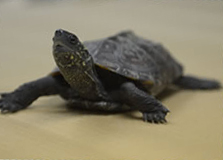
- Aquarium tank
- Filtration system
- Clean water
- UV light
- Basking light
- Basking area such as rocks or bricks
- Access to clean and fresh water
- Adequate and nutritious food
- Registered veterinarian consultation for regular checkups or medical treatment when the turtle is sick, injured or not eating properly
Above all, remember your turtle needs tender loving care!
Feeding
Reeve's turtles are almost exclusively carnivores. This means their nutrition can come from mostly animal protein and some green vegetables. They can consume a variety of food to stay healthy. Turtle feed or pellets are available at pet shops. You should also provide your turtle with fresh food such as fish, shrimp, cooked chicken, lettuce, choy sum, redworms and earthworms, together with the commercial food. Adult turtles require less meat and more vegetables. For younger turtles, it should be fed a diet of higher protein composition. Give your turtle vitamin and calcium powders specially made for reptiles as supplements once or twice a week. If you keep your turtle indoors most of the time, you can feed it calcium powder that contains Vitamin D3. If you keep your turtle outdoors, you can provide a cuttlefish bone in the tank for supplement.
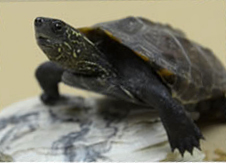
For adult turtles, it should be fed every 1 to 2 days.
For young turtles, it should be fed every day.
For fresh food, feed your turtle till it is full, which is when the turtle slows down eating. For dry food, feed your turtle just enough so that the turtle can finish the dry food within twenty minutes. Do not overfeed your turtle otherwise it can become obese and develop health problems. As turtles usually make a mess when feeding in water, you should feed your turtle in a separate container or tank so that you can dispose of the dirty aquarium water easily.
Correct temperature helps efficient digestion. Cold water can lead to sickness, malnutrition or improper hibernation.
Accommodation
Reeve's turtle is semi-aquatic and adapt well to aquarium setting. Provide your turtle with a large aquarium tank that is big enough for it to swim comfortably. For an adult turtle kept indoors, a 20 gallon aquarium tank should be appropriate. The tank should have a swim area and a basking area. The swim area should have water that is 20 to 40cm deep. The basking area refers to an area above water where the turtle can get completely out of the water to dry off and absorb heat. It should be big enough for the turtle to sit and sunbathe on. You can provide flat smooth bricks or rocks for basking.
During winter, you should install or hang a heat lamp (with a 40 to 60W incandescent light bulb) above the basking area to provide heat for basking. The basking area should be between 27 to 32 degrees Celsius. As for water temperature, it is best if the water is between 24 to 29 degrees Celsius. Therefore you may need an aquarium heater to heat the water in winter. Remember to get a heater protective cover as well to prevent your turtle from getting into direct contact with the heater.
Turtles also need several hours of exposure to natural sunlight every day for proper bone and shell growth. This helps them synthesise Vitamin D3. If you keep your turtle indoors all the time, make sure you provide it with a source of UV light. You can use full spectrum lights. Make sure the lights give ample UVA and UVB output. You should switch it on and off regularly or set a timer every day to imitate day and night cycle. You may consider getting reptile lamps that consolidate the function of heating and UV provision in one.
Cleaning
To keep the water in the tank clean, it is best to change the water daily especially if your turtle feed in the same tank as the leftover food and the turtle’s fecal water can make the water become dirty easily and quickly. If you feed your turtle in a separate tank, change the water in the main tank completely at least once a week. You may also consider using external filter to help keep the water in the tank clean. Do not put any substrates or decorations (such as gravels, stones, etc.) in the tank, they will hold dirt. If the turtle swallows them, these materials can lead to fatal foreign body obstruction.

Interaction
If you feed your turtle in a separate tank at a regular time each day, it will quickly get used to being fed this way and will come over to you to be picked up when it is time for feeding. Remember to wash your hands after contact with your turtle to avoid zoonotic diseases such as salmonella infection.
Some turtles like to be scratched while others may wish to be left alone. Usually, only pick your turtle up when necessary.
If you keep more than one turtle, make sure you provide a big aquarium tank so that they each have enough space to move around freely. Overcrowding is detrimental to their well-being.
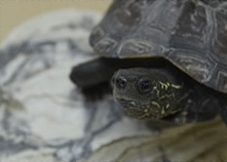
Reptiles and Salmonella infections
Human can be infected with Salmonella through contact with reptiles. Salmonella germs can cause diarrhoea in humans which could be mild, serious or life-threatening. Salmonella is a bacterium that is invisible to human eyes. Reptiles can carry Salmonella germs even though they look clean and healthy. Therefore you should stay vigilant and wash your hands with soap and water thoroughly and immediately after you touch or handle reptiles.
Salmonella germs are shed in reptiles' faeces which can contaminate reptiles' body and habitat. Reptiles that live in aquarium tanks or vivariums can contaminate the water with germs, which in turn can spread to humans.
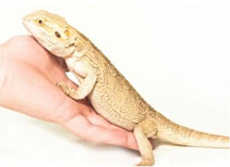
Hygiene measures for reptile owners

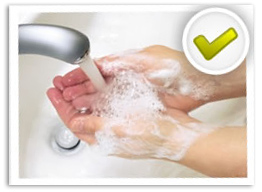
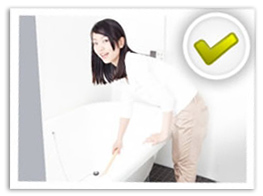
- DO wash your hands with soap and water thoroughly and immediately after you touch, handle or feed reptiles. Do the same after you touch anything in their habitat.
- DO provide adult supervision for children as they handle reptiles and wash their hands immediately after handling.
- If soap and water are not instantly available, DO use alcohol-based handrub immediately. Always wash your hands thoroughly with soap and water as soon as possible.
- To avoid contamination, DO keep reptiles away from kitchen, fomite and other places where food is prepared or consumed.
- If bath is used for washing the aquarium tank / vivarium, DO wash the bath thoroughly afterwards and use bleach to disinfect the bath.

- DO NOT let children under 5 years old, elderly people, or people with weak immune systems handle or touch reptiles.
- DO NOT put the aquarium tank / vivarium containing the reptile in a child's bedroom, especially when the child is younger than 5 years old.
- DO NOT allow reptiles to roam freely in your dwelling.
- DO NOT wash the aquarium tank / vivarium in your bathroom / kitchen basin.
